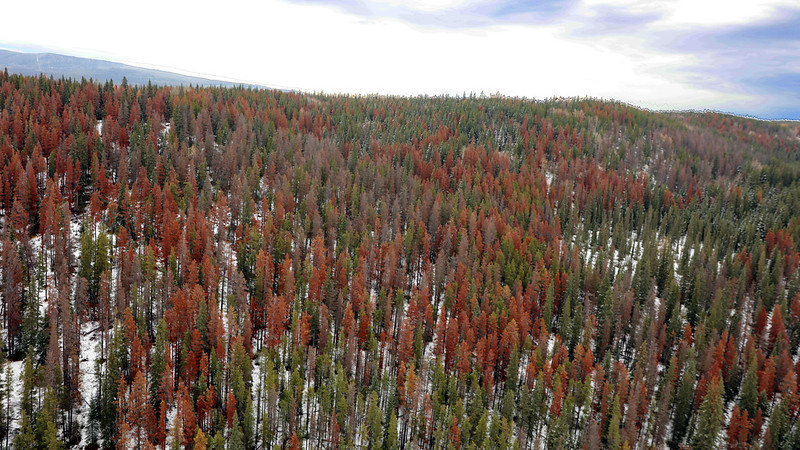
Industry News
News
Mountain pine beetle kept in check through surveying and control
December 15, 2022 By Samantha Johnson, Local Journalism Initiative Reporter
 Mountain pine beetle in the Hinton, Alta., region. Photo: Government of Alberta.
Mountain pine beetle in the Hinton, Alta., region. Photo: Government of Alberta.
The past four years have seen a significant decline in the number of trees killed in Alberta by mountain pine beetle. Population explosions of the beetle occurred in the northwestern United States and B.C. before reaching Alberta and the infestation has generally travelled east to west across Canada.
“We’ve had the advantage of having more time to prepare and learn from the different dynamics of what has happened in other places,” said Louis Price, forest health officer in Calgary with Forestry, Parks and Tourism. “We’ve been lucky enough to put together a program to help manage the infestation.”
A species native to North America, conditions have been favourable for a population expansion of mountain pine beetle for the past several decades.
“It’s what we call an eruptive species,” said Price. “If wind conditions are favourable, it can expand rapidly.”
The beetle hit Alberta, mostly northern and west central regions, in the early 2000s.
The beetle has gone through a couple of population waves and been affected by various ecological controls and weather patterns over time.
“Not until very recently, at the provincial level, over the past two or three years has it really declined,” said Price. “As with many things in nature, it is the result of more than one factor that causes a decline or incline.”
Cold winters combined with the smoky summers of 2019 and 2020 are two contributing factors. The larva of the beetle overwinter under the bark of trees and an early cold snap can result in high mortality rates.
It depends on timing though. The deeper into winter, the more resilient larvae are to cold temperatures. The larvae build up a glycol in their system, which acts as a natural antifreeze. To kill them, they must be shocked, which can be accomplished by a cold dip either in the early fall or late spring, before they build up the glycol or after it’s out of their system.
There are some indications that smoke affects the beetle’s pheromones, and thus, their reproductivity. After the larva develops into an adult, the beetle leaves their host tree and travels to another to reproduce, which smoke could inhibit.
Aggressive control by Forestry, Parks and Tourism are “significant, controlling upwards of 100,000 plus trees per year across Alberta to prevent the expansion of the population,” stated Price.
A three-phase approach is used. Aerial surveying around August identifies areas that have mountain pine beetle, which can kill a tree within a year. An infected tree will be a fresh red or yellow colour and are easy to identify compared to a healthy tree.
In the fall, ground surveys will be undertaken, going to areas identified by GPS to locate and tag the newly infested trees. In winter, crews return to cut and burn trees onsite, which kills the larvae developing under the bark.
Cypress Hills was moderately infected by mountain pine beetle and the beetle has been kept in check by the survey and control methodology as there haven’t been the cold winter temperatures seen up north.
The mountain pine beetle populations in southern Alberta are genetically different than those up north. The population in southern Alberta is well established and has likely adapted to our unique winter weather systems that aren’t experienced up north.
“Even though the populations are declining, continued control is required. The numbers are smaller and we are continuing to kick them while they are down,” said Price.
Samantha Johnson is a Local Journalism Initiative reporter for Medicine Hat News.
Print this page